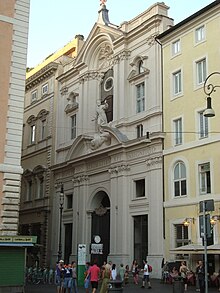
The Church of St. Ignatius of Loyola at Campus Martius is a Latin Catholic titular church, of deaconry rank, dedicated to Ignatius of Loyola, the founder of the Society of Jesus, located in Rome, Italy. Built in Baroque style between 1626 and 1650, the church functioned originally as the chapel of the adjacent Roman College, which moved in 1584 to a new larger building and was renamed the Pontifical Gregorian University. It is one of the great 17th century preaching churches built by Counter-Reformation orders in the Centro Storico.

The Church of the Gesù is the mother church of the Society of Jesus (Jesuits), a Catholic religious order. Officially named Chiesa del Santissimo Nome di Gesù, its façade is "the first truly baroque façade", introducing the baroque style into architecture. The church served as a model for innumerable Jesuit churches all over the world, especially in the central Europe and then in the Portuguese colonies. Its paintings in the nave, crossing, and side chapels became models for Jesuit churches throughout Italy and Europe, as well as those of other orders. The Church of the Gesù is located in the Piazza del Gesù in Rome and is one of the great 17th century preaching churches built by Counter-Reformation orders in the Centro Storico.
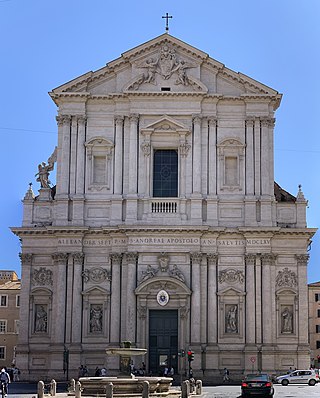
Sant'Andrea della Valle is a titular church and minor basilica in the rione of Sant'Eustachio of the city of Rome, Italy. The basilica is the seat of the general curia of the Theatines and is located on the Piazza Vidoni, at the intersection of Corso Vittorio Emanuele and Corso Rinascimento. It is one of the great 17th century preaching churches built by Counter-Reformation orders in the Centro Storico.

San Francesco a Ripa is a church in Rome, Italy. It is dedicated to Francis of Assisi who once stayed at the adjacent convent. The term Ripa refers to the nearby riverbank of the Tiber.

The Minor Basilica of St. Lawrence in Damaso or simply San Lorenzo in Damaso is a parish and titular church in central Rome, Italy that is dedicated to St. Lawrence, deacon and martyr. It is incorporated into the Palazzo della Cancelleria, which enjoys the extraterritoriality of the Holy See.
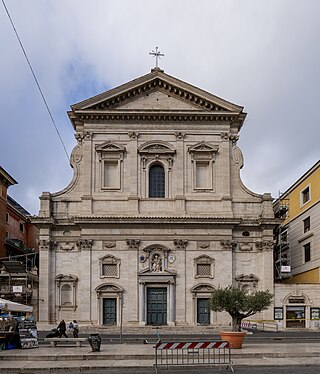
The Church of Santa Maria del Carmelo in Traspontina is a Roman Catholic titular church in Rome, run by the Carmelites. The bridge referred to is the Ponte Sant'Angelo. The church is on the Via della Conciliazione, the primary road of the Roman Rione of Borgo.

Santa Maria in Campitelli or Santa Maria in Portico is a church dedicated to the Virgin Mary on the narrow Piazza di Campitelli in Rione Sant'Angelo, Rome, Italy. The church is served by the Clerics Regular of the Mother of God.

San Francesco da Paola ai Monti is an 18th-century titular church in Rome. It is dedicated to St Francis of Paola, the founder of the Order of Minims, whose friars serve this church and whose Generalate is attached to it, and is located in the Monti rione.

Francesco Trevisani was an Italian painter, active in the period called either early Rococo or late Baroque (barochetto).

San Nicola da Tolentino agli Orti Sallustiani is a church in Rome. It is referred to in both Melchiori's and Venuti's guides as San Niccolò di Tolentino, and in the latter it adds the suffix a Capo le Case. It is one of the two Roman national churches of Armenia. The church was built for the Discalced Augustinians in 1599, and originally dedicated to the 13th century Augustinian friar Saint Nicholas of Tolentino.

The Basilica of Saint Nicholas of Tolentino is a Roman Catholic church and minor basilica that is part of the Augustinian monastery in the hill-town of Tolentino, province of Macerata, Marche, central Italy. The church is a former cathedral of the Roman Catholic Diocese of Tolentino, suppressed in 1586.

San Francesco della Vigna is a Roman Catholic church in the Sestiere of Castello in Venice, northern Italy.

San Gaetano, also known as Santi Michele e Gaetano, is a Baroque church in Florence, Italy, located on the Piazza Antinori, entrusted to the Institute of Christ the King Sovereign Priest.

Jacopo Zoboli, also known by Giacomo, was an Italian painter of the Baroque style.

The Chiesa della Santissima Trinità dei Pellegrini is a Roman Catholic church located on Via dei Pettinari #36 In the rione of Regola of central Rome, Italy. It stands a block away from the Palazzo Spada on Via Capo di Ferro, while a few blocks away on the Via dei Pettinari stands the Ponte Sisto.

Gesù e Maria is a Baroque church located on Via del Corso in the Rione Campo Marzio of central Rome, Italy. It faces across the street the similarly Baroque facade of San Giacomo in Augusta.
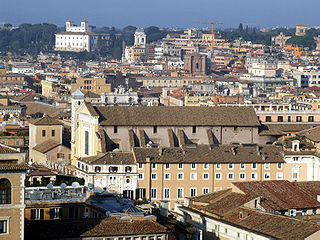
Santi Dodici Apostoli, commonly known as Santi Apostoli, is a 6th-century Catholic parish and titular church and minor basilica in Rome, Italy, the mother church of the Conventual Franciscan Order whose General Curia is in the adjacent building. Dedicated originally to St. James and St. Philip whose relics are kept here, and later to all Apostles, it is the Station church for Friday, the first week of Lent.

Santi Quaranta Martiri e San Pasquale Baylon is a Franciscan Catholic church, built in a late-Baroque style, located on Via San Francesco a Ripa in the Rione Trastevere, Rome, Italy.

Matteo Pannaria or Panaria or Pannerio was an Italian painter of the late-Baroque. He was born in Palermo, Sicily and active both in Rome and Jesi. He painted a Glory of San Giovanni Nepomuceno (1753) for the church of San Giovanni Battista in Jesi. He frescoed the ovals in the ceiling of the church of Santi Quaranta Martiri in Rome. Over the nave is the Glory of San Pedro de Alcantara, while the transept crossing depicts Glory of San Pascual. He also painted Beato Giovanni of Prado in one of the chapels.
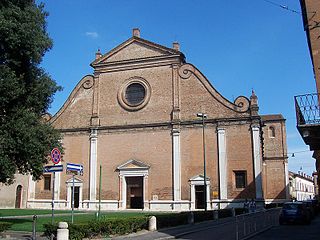
San Francesco is a late-Renaissance, Roman Catholic minor basilica church located on via Terranuova in Ferrara, Emilia-Romagna, Italy.
